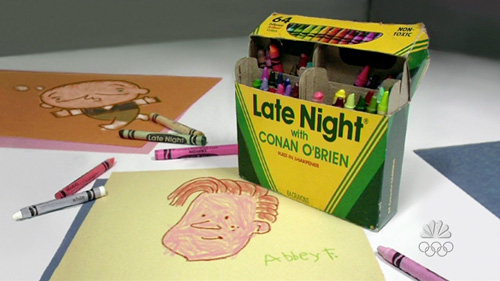Good video overview of James Marks’ newest venture: SPUR studios.
Like a mini Russel Industrial Center for the Ypsi / Arbor area. These are exactly the kinds of things Michigan needs.
Good video overview of James Marks’ newest venture: SPUR studios.
Like a mini Russel Industrial Center for the Ypsi / Arbor area. These are exactly the kinds of things Michigan needs.
A few weeks back I saw an interesting music app written up on lifehacker, and I bookmarked it to download and play around with during some of my ample free time. That app was RGBMusicLab, and it is no longer available.
Why is it no longer available? Because someone contacted the programmer, Kenji Kojima, and notified him that they had patented the act of turning the colors Red, Green, and Blue into music and that they planned on pursuing legal action if Kojima didn’t purchase a license and credit the patent holder in any public exhibitions of artworks generated by the code that Kojima himself wrote.
The patent in question is here. I’m not an Intellectual Property lawyer, so I won’t claim any insight into the validity of these claims, but my general feeling on the matter is: that sucks. If the act of converting a visual state into an aural state is patentable, then why, for example, hasn’t someone patented the act of reading aloud in English?
Of course, this kind of thing happens every day, but the distinguishing factor of this particular instance, for me, was the way in which Kojima communicated the removal. He removed the program’s page, and replaced it with the following simple message:
“Dear people,
I was informed that I had to remove RGB MusicLab from the web site from a person who had a patent that enabling the interpretation of color as music. I have never known it was a patent technology. And I believed such a basic process belonged to all humankind. Moreover RGB MusicLab was realized by many other great technologies of anonymous. Though I have to remove it by the US law.
Kenji Kojima”
The link to the zip file, which had by this time migrated to all sorts of download sites, was replaced by a new zip, containing only the above message as a text file.
I will admit: I am definitely guilty of having Idea Inaction Remorse (I just made that up, but it sounds real) – meaning I have ideas, don’t do anything with them and eventually see them realized by others. The leap I cannot understand is taking that next step – to aggressively pursue shutting down another person who had the perseverance to carry things through to fruition.
It occurs to me that anyone with an approved and adequately vague patent can sit around all day searching the latest feeds for new creative projects to try to extort licensing fees from, and that’s just kind of sad. As Kojima said in an email:
“Color to music is intellectual property of art/science research. And I shared my studies with people. It must not be regulated by a US patent. All artist in 21st century have be a refugee from US.”
I did eventually get my hands on the software (I played around with the mac version), and you know what? It’s great. It’s a solid, feature-rich, educational program that was being offered for free across multiple platforms (Kojima used Runtime Revolution to port his code between mac and PC versions). Too bad.
Below is a screen shot of what the interface looks like encoding a photo:
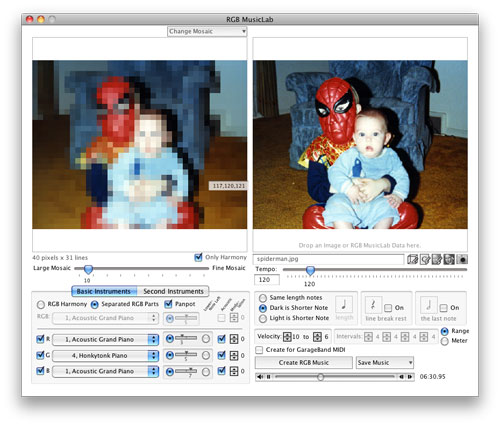
You turn your image into a mosaic of adjustable resolution, and choose an instrument, volume and panning to assign to the colors red, blue and green. The music is generated by iterating through each pixel of the mosaic – row by row, left to right. For each pixel, a three note harmony is played, with the length of the note determined by the brightness of the pixel. It’s interesting to try to follow along with the generated music by ‘sight-reading’ the mosaic based on the colors of each square, and the user can adjust the tempo and add rests between lines to make this easier.
Since the program is unavailable and you can’t try it for yourself, here’s a simplified version of the mosaic above, immediately followed by the MP3 I generated. In this example, the part of Red was played by an Acoustic Grand Piano, Blue was a Slap Bass, and Green was a Trumpet:
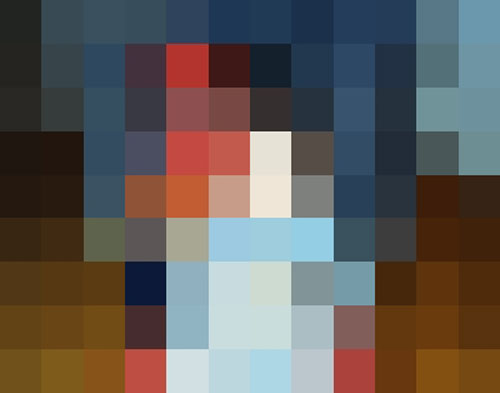
The good news: Kenji Kojima has tons of interesting multimedia works on his website, and he says he’s working on a similar program to interpret 3d models. Unfortunately, an echo of the chilling effect that intellectual property ugliness can yield came through loud and clear in an email Kojima sent me describing his current work: “I hope nobody hold unreasonable patent of it.”
Update: The patent owner who was threatening action failed to pay maintenance fees on the patent in question and it has now expired, so RGBMusicLab is back up! Yay!
Why now? Did Salinger's passing shake him up? Regardless, I bet Nevin Martell is pissed.
I happened upon the Growing Up Heroes tumblr in my internet travels whilst in the process of digitizing a big ‘ol box of family photos. The design is a little rough, but it’s a great concept: user-submitted photos of childhood superhero costumes.
Wired summarizes the feeling of the resultant collection nicely: “…brings back vivid memories of our own attempts to be heroes when we were uncomplicated, over-imaginative, nerdy kids.”
Anyway, I submitted all of the ‘hero-centric’ halloween shots I had, and they posted two of them today (One, Two). One from 1985 featuring yours truly as Spiderman and my brother Chris as a one-year old, and another from 1987, with my brother and I wearing Captain America and Flash costumes hand-made by my mother. Nerd alert!

Fiona Apple and Jon Brion cover Billie Holiday as a part of a Haiti benefit at Largo.
I would buy an album of recordings like this.
90’s surf rock giants Man… or astroman? to reunite.
Key: Original lineup, which I only got to see once, at St. Andrew's Hall in Detroit. "It was not atypical for Man or Astro-Man? to arrive at a club, set up for 5 hours, play a show as hard as you possibly could, break down for 3 hours and talk to everyone until the last kid left, drive to the next city overnight, wake up at 10:00 AM and do some fanzine interview, play on the local college radio station shortly after lunch, then do an in-store thing at 4, go to the club and set up, then (if the club was over 21) do a short 20 minute full stage show for underage kids when the clubs would be closed during our soundcheck, and then finally play our full show again and repeat the process the next day. We thought that was what every band did."
Design for chess pieces in which their top-down view serves as a diagram for legal moves.
I love this idea, but I'm not particularly informed on the comings and goings of the chess world, so I have no idea if this is something that's been done before. I think the king and pawn designs could use a little tinkering… this would be a great assignment to put in front of industrial design students.
By some strange series of events, seven whole seconds of a song on which I played drums ended up in the tail end of a Ford ad (Online only, but still):
This ad is one in a series called ‘One More Reason,’ in which Ford owners are interviewed about their favorite features of various Ford cars and trucks.
In summary: I turned 30 and immediately started selling out to car companies. Just kidding. My last three cars have been Fords, and just recently I had a great customer service experience with them. I’m actually weirdly into the idea that Ford was the company that we ended up in an ad for.
Weird times.
Pixar animator Angus MacLane’s ‘Cubedudes’ – Lego likenesses of pop culture characters.
Something for nerds of all stripes.
One of the pieces of ‘bumper’ art on tonight’s episode of Conan’s Tonight Show was the piece below, expertly echoing the ‘circular shorthand’ style that Chris Ware has used in a number of strips and in two animated shorts for the ‘This American Life’ TV show.
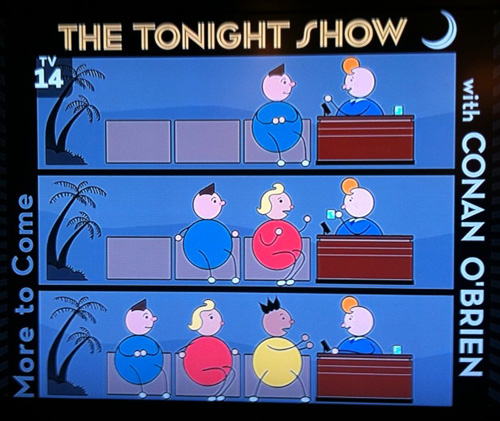
Below is an example of the Ware strips I’m referring to, taken from the cover to a recent Penguin edition of ‘Candide.’
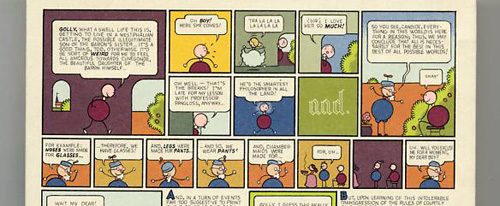
There is a long history of Conan’s bumper art paying homage to disparate pieces of visual inspiration. Awhile back, there was a great website collecting all of these homage images here, but it looks like it’s fallen off the web. In a Metafilter discussion of that site, the name Kevin Frank is floated as the mastermind of all this, and following up on that lead brought me to his Flickr account, which has a gallery of all the bumpers with commentary. In case any are missing there, it looks like the content from the first site is also up here. The internet.
An homage to Ware’s work previously surfaced in the background to a piece of Conan’s bumper art in November of 2005. If you don’t see it, Ware’s Jimmy Corrigan is the ‘Non-Conan’ drawing. Thanks to Ted Miller for originally pointing it out!
